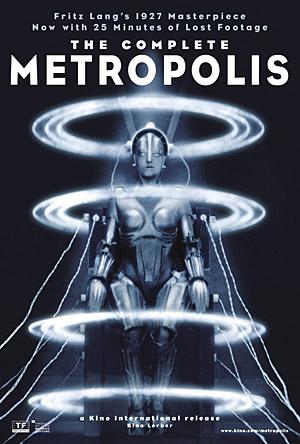Alli Jessing, Joint Programs Coordinator for the Smithsonian American Art Museum and National Portrait Gallery, spoke with Carlos Garza and Rich O'Meara of Silent Orchestra about their upcoming cineconcert. On May 14, 2011, the duo will premiere a new score that they have composed for the classic 1927 German expressionist film Metropolis. The cineconcert begins at 3 p.m. in the museums' McEvoy Auditorium. The program is free, but tickets are required. Tickets will be available in the G Street lobby thirty minutes prior to the performance.

Image Courtesy of Kino International
Eye Level: This is a new score for Metropolis. How does it differ from the original or previously released scores?
Silent Orchestra: Our new score has all the elements of our signature sound; modern cinematic keyboard textures and sound effects, realistic orchestral emulations, live percussion, and driving rhythms. The original score is an orchestral work rooted in late Romantic and early twentieth century forms. There have been many other musical settings, including a 1980s rock opera approach by Georgio Moroder. We have found new ways to portray director Lang's intent that will resonate with today's film audiences and keep them focused on the story and the amazing cinematography.
EL: Do you write music differently for the different characters in the film? If so, are some easier to write for than others?
SO: Certain motifs will be repeated throughout the film to connect locations and characters. One of the joys of scoring is the opportunity to try different arrangements of the principle themes. For example, Maria's theme is at first gentle, but later the same music is played in a more powerful way for the robot Maria.
The recent film restoration includes more of the subplot involving Slim, the spy who works for the head of the city. We gave him a diminished scale motif on the low notes of the piano. His motif is more brief and does not need variation like Maria's theme did.
Lang was fascinated with crowd dynamics and you can see this throughout the film. For example, when the workers are coming on shift and leaving their shift, they march, or plod in rectangular columns. At the end, they march in a triangular shape up to the church where the final climactic scenes have transpired. We gave the workers several motifs depending on the situation: working, marching in unison, or running around chaotically.
EL: What scene was the most fun to score? The most challenging?
SO: The robot activation scene found us smiling the most. It's a mad scientist at work in his laboratory, what could be more fun?! Our treatment with bubbling sound effects and throbbing synthesizers has not been tried yet to our knowledge.
A unique paradox of silent film screenings since the early days is that the audience cannot hear the characters speaking but sound effects are frequently supplied through musical accompaniment or other performers. In Metropolis, the large steam whistle plays a role in amplifying the drudgery of the works shifts. That drudgery resonates with the character, Freder, the son of the head of the city. At times he appears to be hearing the whistle even when it is not time for the shift change. The audience will hear that sound when the whistle blows and also when Freder alone is hearing it in his head. We are highlighting several story elements like this that are not highlighted in other Metropolis scores.
The most challenging aspect is the sheer length of the film. How do we keep the audience engaged without wearing them out? Again, the ability (or need) to arrange the music for different settings provides continuity and variation that will keep the audience engaged and entertained.
EL: Do you start with a rough structure for the score or do you create it as you move along?
SO: We start by creating a detailed log that includes story elements, important events and visual cues, and any musical ideas that occur to us as we form an outline. Then we work together and separately to compose and record section by section. As we improvise on these ideas they become more concrete and character themes emerge. By recording our improvisations, we are able to try them in different parts of the film very easily. It is a very exciting collaborative process.
EL: Last time you were here, you performed a score for Salome. Next up: Metropolis. Are there any other projects in the works that we can look forward to?
SO: Our next goal is to complete the editing for the Salome CD, and after that, hopefully a Metropolis CD. We would like to record our score for a Germain Dulac classic silent film, and a friend of ours has a contemporary silent short film project in the works. Future projects will be announced on our website, SilentOrchestra.com.
If you'd like a preview of their score, Silent Orchestra has uploaded highlights at SoundCloud.com.
- Metropolis, Film, Film Score, Silent Orchestra, American Art, Smithsonian American Art Museum

